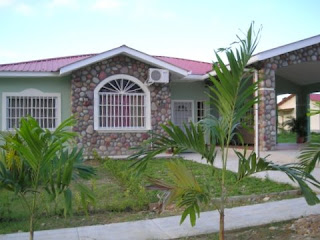El Jefe and I were absolutely incredulous to find that the houses in colonia Rancho Lima had increased in price by about 30% since we were there in February.
We also wonder where all the people are coming from and where the money is coming from. La Ceiba has actually lost industries in the past seven years, not gained them, except possibly a few more stores than in the past. I just don't think that there has been any sort of large increase in jobs. Wages have increased, but don't even keep pace with the cost of living.
New colonias are popping up everywhere! I mean everywhere. Some are large, some are small. Some are very expensive, many are middle-class range, and some are very small, two or three room starter-type houses. But very few are the type that you would expect someone who has been living in a tin shack by the river could afford, so where are they coming from? The houses seem to fill as soon as they are built.
 I don't get around all that much, so I notice the change more. One day there is an empty field. The next time I see it, 50 houses are being built. The next time, it is a full blown colonia with landscaping, kids outside playing, people washing their cars − as if it had been there forever.
I don't get around all that much, so I notice the change more. One day there is an empty field. The next time I see it, 50 houses are being built. The next time, it is a full blown colonia with landscaping, kids outside playing, people washing their cars − as if it had been there forever.It's not as if El Centro was empty and everyone has moved to the suburbs. It's also not as if people are moving here from the country for jobs, because there just aren't that many jobs in La Ceiba. I have a terrible feeling that it has to do with credit and that the overextending of credit is going to crash Honduras down worse than Hurricane Mitch. Most Honduran people just don't understand credit and in my opinion the banks are making it way too easy for people to overextend themselves at very high interest rates. (Credit card rates run around 60% annual interest.)
Our US brother- and sister-in-law were crushed to find out that these houses ran from US $81,000 to $102,000. These are nice houses, don't get me wrong, but they are very small 3-bedroom, 2-bath homes with almost no property other than a small front yard. The smallest house is 98 square meters or 1,055 sq. ft. The largest is 141 square meters or 1,518 sq. ft. − that is a small house by US standards.
The interest rate on a 20-year mortgage is 10.5% in Rancho Lima, with 10% down. I haven't heard that 30-year mortgages are available in Honduras. The sales rep said that 10.5% was the best rate that can be had in Honduras and that it was way down from 20-22% a few years ago.
He calculated the payment, after some strange wranglings with a "discount" and a "reserve", to be US $917 per month with a 20-year mortgage or $1,015 with a 15-year mortgage. That is L.17,331 (or L.19,184 on the 15-year loan) in a country where an average middle class salary is, oh, around L.7-10,000 per month and a salary of L.17,000 per month is considered very good. It is much less common for both the husband and wife to work in Honduras than it is in the US.
 Okay, I know Bob will bring this up and I've mentioned it before: There is a lot of speculation that drug money is behind the construction boom in La Ceiba. I don't doubt that at all, but I don't think that everyone is involved with narcotrafficking. It just can't be....Can it?
Okay, I know Bob will bring this up and I've mentioned it before: There is a lot of speculation that drug money is behind the construction boom in La Ceiba. I don't doubt that at all, but I don't think that everyone is involved with narcotrafficking. It just can't be....Can it?Another aspect is the remesas (cash remittances) from family members in the US. Those funds coming from the US allow many families to live way beyond what they could ever hope for, working or not. The sales representative implied that many of the homes were being purchased by Hondurans working in the US and foreigners from other countries. A million of those Hondurans live in the US very tenuously and could lose their job or be sent home at any time. Unless their house is paid for before they move back to Honduras, they'll have a very tough time replacing that US salary in La Ceiba.
Our architect told us once that real estate never loses value in (mainland) Honduras. I kind of chuckled at the time, but who knows? The price of construction materials has had huge increases since we built our house. The price of concrete alone, one of the biggest expenses, had more than doubled and the cost of iron has increased tremendously.
It's all very confusing to me. The country is poor, people are starving, there are no jobs, yet in a blink of an eye, thousands of new houses are sold and paid for at huge interest rates. What is going on?
Wow. I wonder what our house is worth? It must be worth about 5 million by now − lempiras that is, not dollars. :-D



 Welcome to my Blogicito —
Welcome to my Blogicito — 







